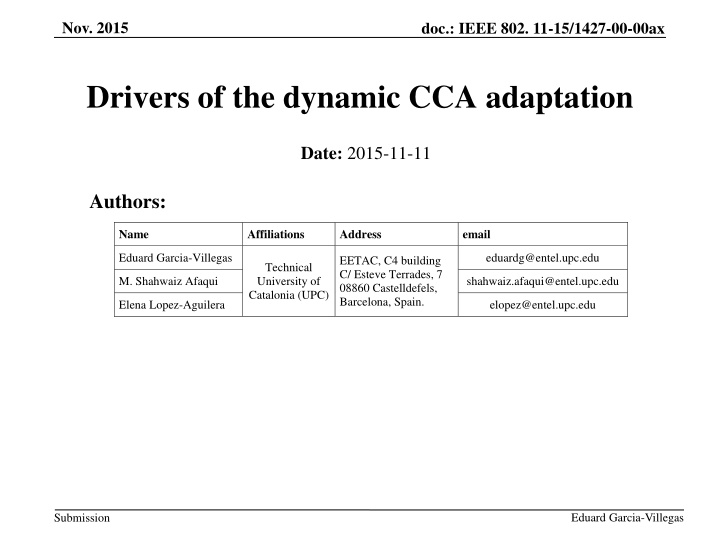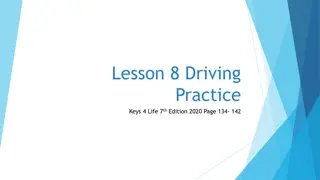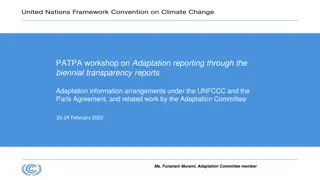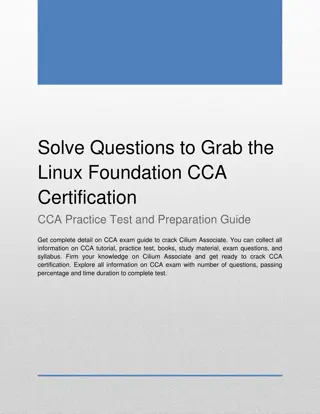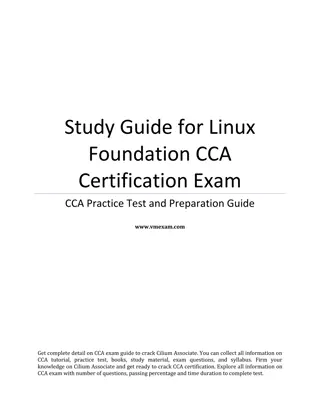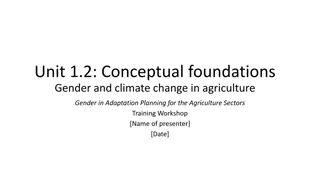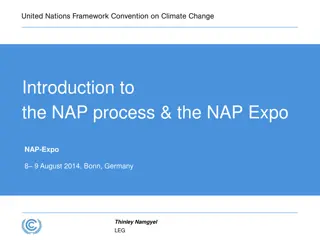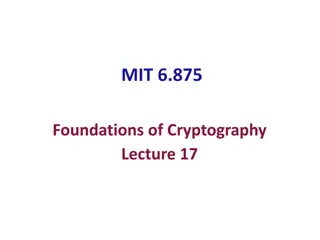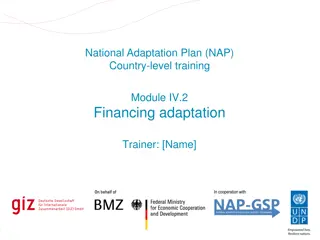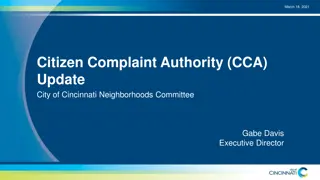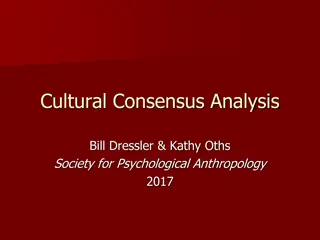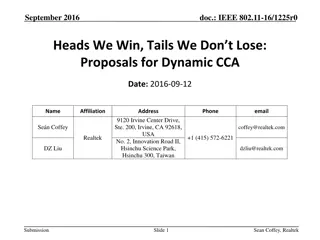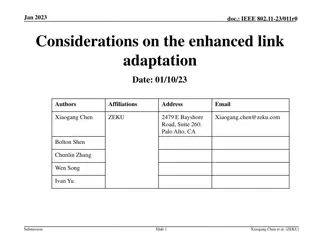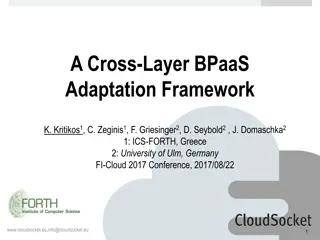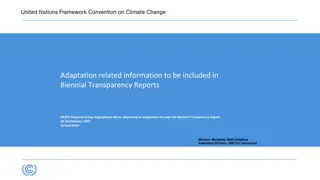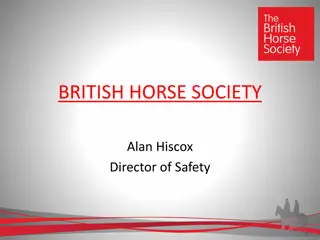Drivers of the dynamic CCA adaptation
This document delves into the drivers behind the dynamic Clear Channel Assessment (CCA) adaptation in the IEEE 802.11 standard. It discusses the communication model, optimal CCA threshold setting, comparison between different schemes, and conclusions drawn from the studies. The focus is on understanding the mechanisms influencing CCA adaptation for throughput improvements in wireless communication.
Uploaded on Feb 23, 2025 | 1 Views
Download Presentation

Please find below an Image/Link to download the presentation.
The content on the website is provided AS IS for your information and personal use only. It may not be sold, licensed, or shared on other websites without obtaining consent from the author.If you encounter any issues during the download, it is possible that the publisher has removed the file from their server.
You are allowed to download the files provided on this website for personal or commercial use, subject to the condition that they are used lawfully. All files are the property of their respective owners.
The content on the website is provided AS IS for your information and personal use only. It may not be sold, licensed, or shared on other websites without obtaining consent from the author.
E N D
Presentation Transcript
Nov. 2015 doc.: IEEE 802. 11-15/1427-00-00ax Drivers of the dynamic CCA adaptation Date: 2015-11-11 Authors: Name Affiliations Address email Eduard Garcia-Villegas eduardg@entel.upc.edu EETAC, C4 building C/ Esteve Terrades, 7 08860 Castelldefels, Barcelona, Spain. Technical University of Catalonia (UPC) M. Shahwaiz Afaqui shahwaiz.afaqui@entel.upc.edu Elena Lopez-Aguilera elopez@entel.upc.edu Eduard Garcia-Villegas Submission
Nov. 2015 doc.: IEEE 802. 11-15/1427-00-00ax Outline 1. Context 2. Communication model 3. Optimal setting of CCA Threshold 4. DSC vs. fixed CCA threshold scheme 5. Conclusions 6. References Eduard Garcia-Villegas Submission
Nov. 2015 doc.: IEEE 802. 11-15/1427-00-00ax 1. Context Many contributions to the TGax study CCA adaptation (more than 70 references and counting [1]) ( and many of them start with this same sentence) Most of the studies are based on static CCA thresholds settings; few dynamic/adaptive mechanisms were proposed (based on intuitive heuristics). In all cases, throughput improvements are observed Following a simple approach, in this work we try to provide a theoretical background to better understand CCA adaptation and its drivers. Eduard Garcia-Villegas Submission
Nov. 2015 doc.: IEEE 802. 11-15/1427-00-00ax 2. Communication model H is an IEEE 802.11 STA Pt tx power Sr receiver sensitivity Rr reception range X G ?? ?? ?? ?? ?? ?? A B C ?? D Rr d is the distance tx rx is the path loss exponent represents a tx rx link E F For simplicity, assume that all nodes have equal properties (i.e. same Pt, Sr, etc.) Eduard Garcia-Villegas Submission Slide 4
Nov. 2015 doc.: IEEE 802. 11-15/1427-00-00ax 2. Communication model H is an IEEE 802.11 STA Pt tx power CCATh carrier sense Threshold Rc carrier sense range X Rc G ?? A B C ?? ?? ????? D d is the distance tx rx is the path loss exponent represents a tx rx link E F For simplicity, assume that all nodes have equal properties (i.e. same Pt, Sr, etc.) Eduard Garcia-Villegas Submission Slide 5
doc.: IEEE 802. 11-15/1427-00-00ax 2. Communication model Capture effect Upon a collision, the receiver locks to a strongest PPDU provided that it is, at least, CTh times stronger than the current frame. CTh : capture threshold This ability defines the interference range (Ri) Any s transmission within Ri is received with power not CTh times lower than the wanted transmission prevents the wanted transmission to benefit from the capture effect upon collision, prevents the correct reception of the wanted transmission. X Interesting behavior that allows increasing spatial reuse [4] Eduard Garcia-Villegas Submission Slide 6
Nov. 2015 doc.: IEEE 802. 11-15/1427-00-00ax 2. Communication model H is an IEEE 802.11 STA Pxy power received at Y from X dxy distance between Y and X CTh capture threshold if is at the edge of B sRi C X G Ri A B C ??= ??? ???? ??? D ??? ??? ? ??? ??? ??? E F ? ? (*) ??? ?????? is the path loss exponent For simplicity, assume that all nodes have equal properties (i.e. same Pt, Sr, etc.) Eduard Garcia-Villegas Submission Slide 7
Nov. 2015 doc.: IEEE 802. 11-15/1427-00-00ax 2. Communication model Setting an optimal CCATh Leverage the capture effect Ideally sRc limits coincide with B sRi limits (increases spatial reuse destructive interference) In the worst case (A, B and C are on the same line): H Rc A G B Ri while avoids R*c A B C = ???= ???+??? ? ? ?? D ?? ?????= ??? ? ???+ ??? from (*): E F ??? ?????= ??? ? ??+ ? ??? For simplicity, assume that all nodes have equal properties (i.e. same Pt, Sr, etc.) Eduard Garcia-Villegas Submission Slide 8
doc.: IEEE 802. 11-15/1427-00-00ax 3. Optimal setting of CCATh From our simple communication model ??? ? ? ?????= ? ??+ ? ??? Margin = 20dB (realistic) Numerical example: STA receives -40dBm from its AP CTh = 15dB CCATh -60dBm = 3.5 That is, in terms of DSC algorithm [2]: CCATh can be computed from the measured power of received beacons minus a Margin By means of simulations, in [3] the optimal Margin was found to be 20dB Eduard Garcia-Villegas Submission Slide 9
doc.: IEEE 802. 11-15/1427-00-00ax 3. Optimal setting of CCATh From a more generic perspective CCATh = f(CTh , path losses, Pt ) CTh= f(MCS, preamble/payload stage,...see [5]) CCATh should be different at each STA and it should vary dynamically (with tx power, mobility, MCS, etc.) Eduard Garcia-Villegas Submission Slide 10
doc.: IEEE 802. 11-15/1427-00-00ax 4. DSC vs. fixed CCA threshold scheme To support our previous claim we run simulations in residential building scenario: dynamic/adaptable approach (DSC) vs. best fixed threshold (FCST) NS-3 simulations IEEE 802.11n without aggregation (other simulation details can be found in [3]). FCST = -65dBm 18 80 FER Hidden nodes Throughput Fairness 16 70 14 60 12 % Increase 50 % Increase 10 40 8 6 30 4 20 2 10 0 0 DSC FCST DSC FCST DSC slightly outperforms FCST in terms of throughput DSC provided better FER when compared with FCST. Eduard Garcia-Villegas Submission Slide 11
Nov. 2015 doc.: IEEE 802. 11-15/1427-00-00ax 5. Conclusions In this presentation, we provide a simple communication model to justify the use of dynamic CCATh adaptation Improve spatial reuse while keeping interference at acceptable levels Sensible adaptation of CCATh should depend on: TX Power MCS of transmission Type of scenario (different propagation loss characteristics) Simulation results support our claim that the drawbacks of increasing spatial reuse are reduced when CCATh is adapted per STA. Eduard Garcia-Villegas Submission Slide 12
Nov. 2015 doc.: IEEE 802. 11-15/1427-00-00ax 7. References [1] 11-15/1138r1, To DSC or not to DSC [2] 11-13/1290r1, Dynamic Sensitivity Control for HEW [3] 11-15/0027r1, Simulation-based evaluation of DSC in residential scenario [4] with/without Capture Effect 11-15/1302r2, System Level Simulator Evaluation [5] J. Lee, W. Kim, S.-J. Lee, D. Jo, J. Ryu, T. Kwon, and Y. Choi, An experimental study on the capture effect in 802.11a networks, in ACM WiNTECH, 2007 13 Eduard Garcia-Villegas Submission
